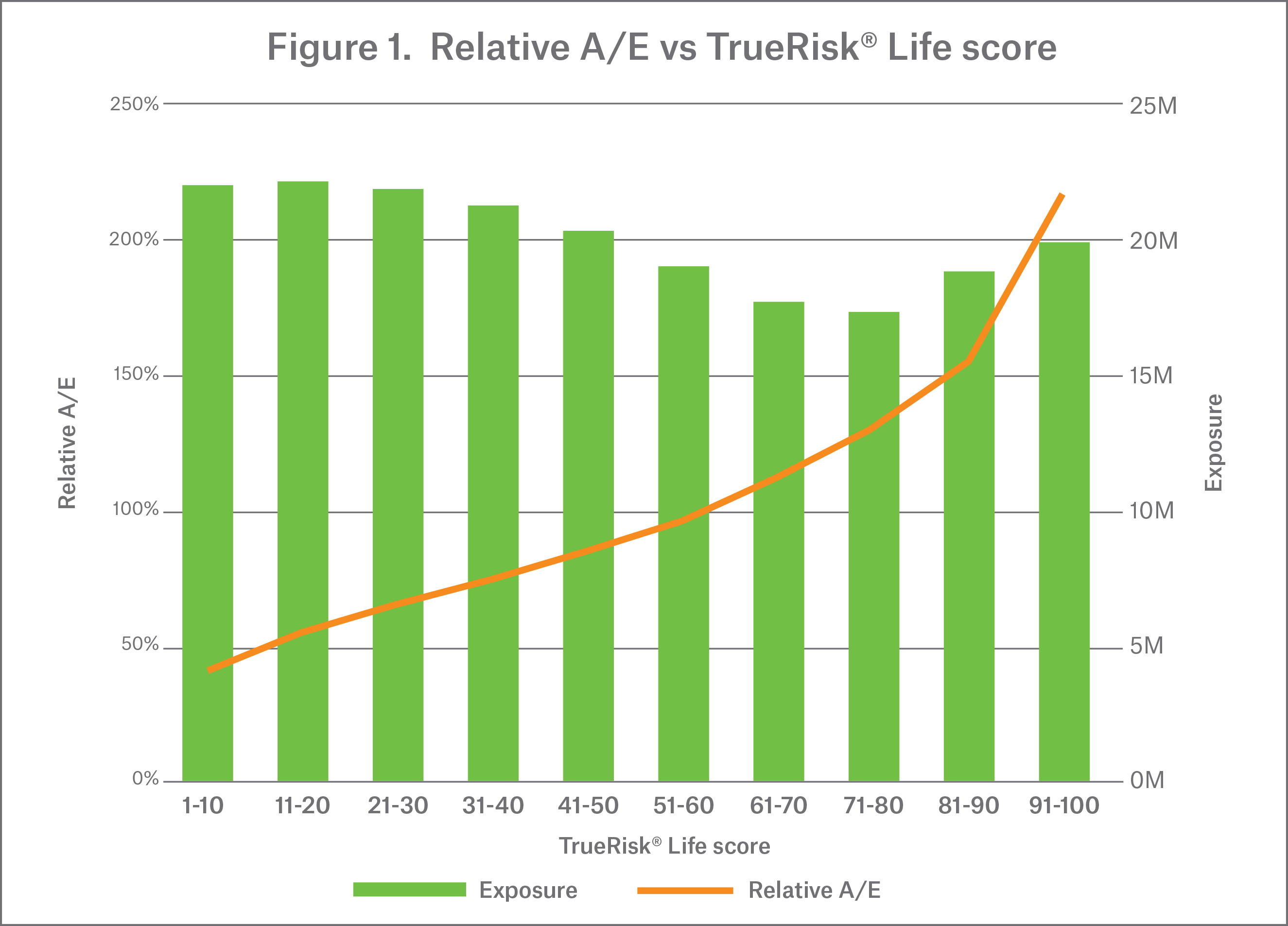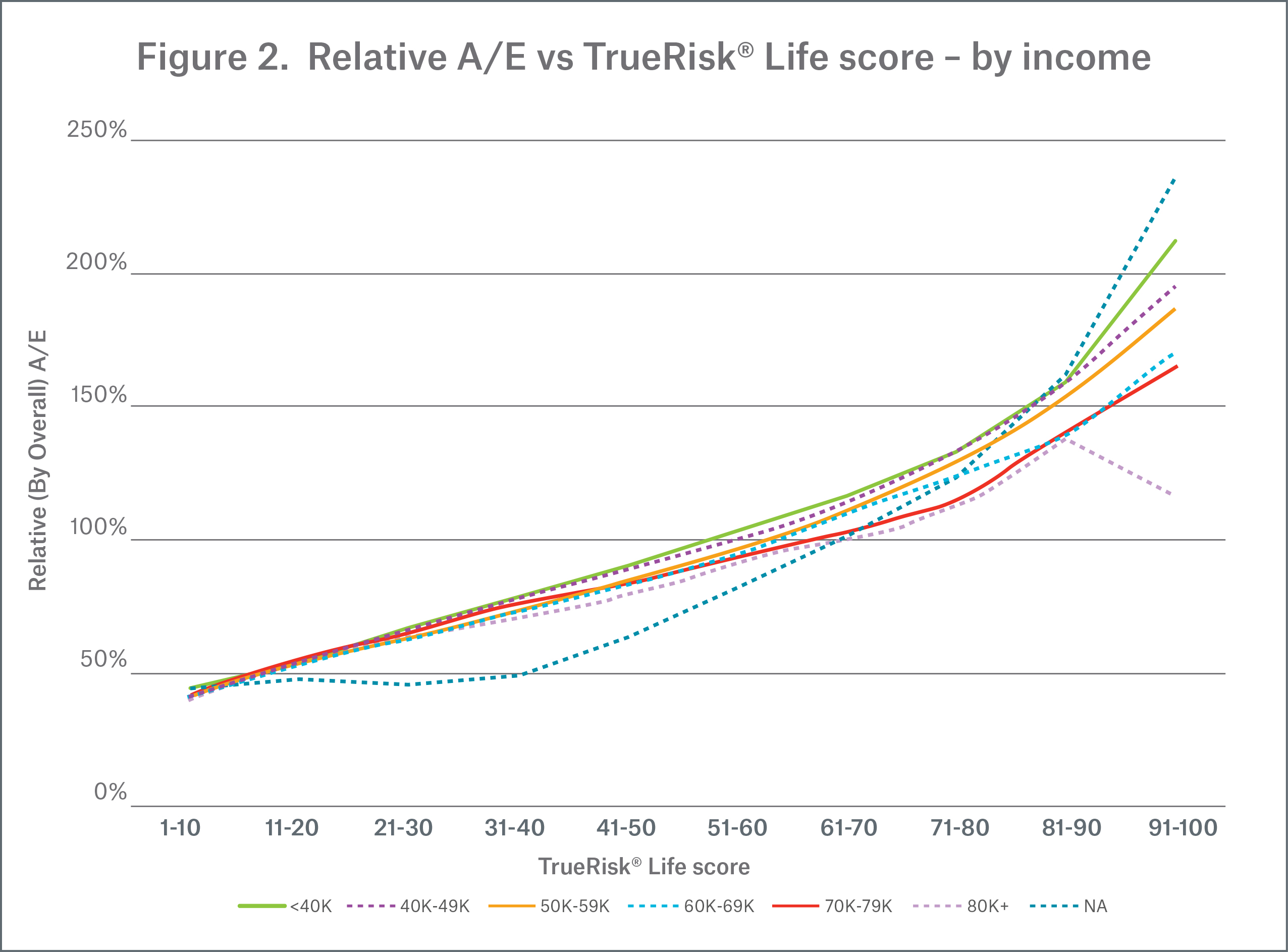
Predictive models and life insurance
TransUnion allowed Munich Re to assess TrueRisk® Life Score, a predictive modelling tool developed and owned by TransUnion that accurately assesses mortality risk using individual credit information. Insurers considering credit-based scores should begin with a retro-spec-tive validation study on their own experience data. Munich Re can assist carriers with the retrospective study, advise on changes to mortality assumptions and recommend how to incorporate the scores to streamline underwriting.
Executive summary
The TransUnion TrueRisk® Life Score is a proprietary scoring algorithm that includes credit information to predict the relative mortality risk of individuals. TrueRisk® Life Score assigns a score ranging from one to 100, where low scores represent relatively better mortality and high scores reflect worse mortality.
TransUnion provided 16 million lives sampled from the U.S. general population to Munich Re. Munich Re reviewed the sample, validated the results, and confirmed that the scores produced by the model are predictive of mortality for the U.S. general population. Munich Re also recommended replicating the study on an insured dataset to help assess the value of the TrueRisk® Life Score for insured applicants; an insured population is not expected to have the same underlying characteristics as a general population.
Key findings
Primary high-level findings include the following:
- Mortality risks increase as the TrueRisk® Life Scores increase.
- The TrueRisk® Life Score stratifies mortality risk across attributes provided by TransUnion.
- Younger applicants constitute a greater proportion of applicants whose estimated income is labeled as N/A – a group associated with high scores; they may not have accumulated sufficient credit-related histories. Note that this is based on the 10% of applicants with an estimated income labeled N/A.
- The TrueRisk® Life Score effectively segments mortality across income bands.
Life insurers interested in the TrueRisk® Life Score should conduct a retrospective study in order to calibrate the TrueRisk® Life Score to the carrier’s own underwriting paradigm. This process will help carriers balance the score with expected mortality with respect to their unique target markets, distribution channels, and other underwriting tools.
Methodology
Munich Re assessed the effective-ness of the TrueRisk® Life score in stratifying the mortality risk profile of a pool of 16 million applicants with entry ages 20-70, pulled from a 1998 archive database on a quarterly basis. Deaths were sourced from the October 2011 Social Security Death Master File. Due to a known lag in reporting of deaths, the study end date was set to December 31, 2010. The study population is comprised of 1,144,078 deaths out of 199 million exposed life-years.
The expected mortality basis was taken from the Human Mortality Database U.S. Life Tables, which represent U.S. population mortality, split by gender, age, and calendar year with adjustments. The calendar year splits adjust for mortality improvement over the 13 year study duration. TransUnion uses first names in their proprietary database to derive gender and chooses 90 percent confidence level as threshold for scoring. They only identify a person’s gender when the name is associated with a particular gender more than 90 percent of the time. To account for this minor imprecision, a 90 percent/10 percent blend of gender-specific mortality rates was used for both genders. We tested other blends and observed similar results.
Munich Re completed additional analyses of relative actual to expected ratio (A/E) by various factors (e.g., age, gender, duration,
region, and income) to assess whether the mortality risk stratifi-ca-tion by TrueRisk® Life score is influenced by those factors.
Overall Results
Figure 1 provides a high level overview of the validation that the TrueRisk® Life score stratifies mortality risk. Lives with higher TrueRisk® Life score have higher mortality risk, while lower TrueRisk® Life scores correspond with lower mortality risk.

Income
Income was provided by TransUnion, calculated using their Income Estimator 3.0 Model. The TransUnion Income Estimator 3.0 Model uses individual-level credit data to estimate income. It was developed using linear regression (OLS) with TransUnion’s proprietary generic characteristics serving as the predictors.
Target variable was provided by Interthinx, Inc. They provided mortgage applica-tion data from their entire client database, which according to TransUnion, includes over 1,400 customers, 15 of the top 20 mortgage lenders, and three of the top five financial institutions.
Applicants with insufficient individual credit data are not assigned an estimated income. Approximately 10 percent of the modified population did not have an estimated income; they are labeled as N/A.
The TrueRisk® Life Score segments mortality regardless of income group. Furthermore, although applicants with an income estimated at $70 thousand or more are sparsely distributed in the higher score groups, the TrueRisk® Life score still effectively stratifies mortality risk. Note that the drop in relative A/E at high score values for annual incomes low count of deaths (<100) in that segment (Figure 2).



Summary
Munich Re concludes the TrueRisk® Life Score is an effective predictor of mortality for the U.S. general population. The TrueRisk® Life Score stratifies mortality risk across attributes. Furthermore, the analysis of income demonstrates that the TrueRisk® Life score is not a proxy for affluence and effectively segments mortality across different income bands. Finally, as an insured population is not expected to have the same underlying characteristics as a general population, replicating the study on an insured dataset would help confirm the value of the TrueRisk® Life score for insured applicants.
Downloads
Contact the Author:
/Sandra%20Chefitz.jpg/_jcr_content/renditions/crop-1x1-400.jpg./crop-1x1-400.jpg)
Newsletter
properties.trackTitle
properties.trackSubtitle